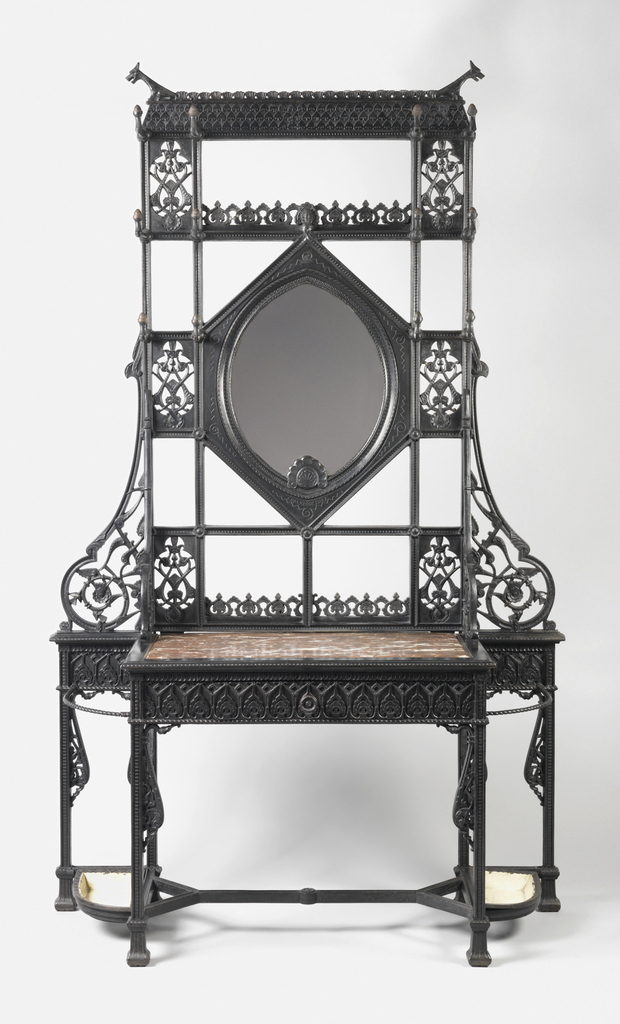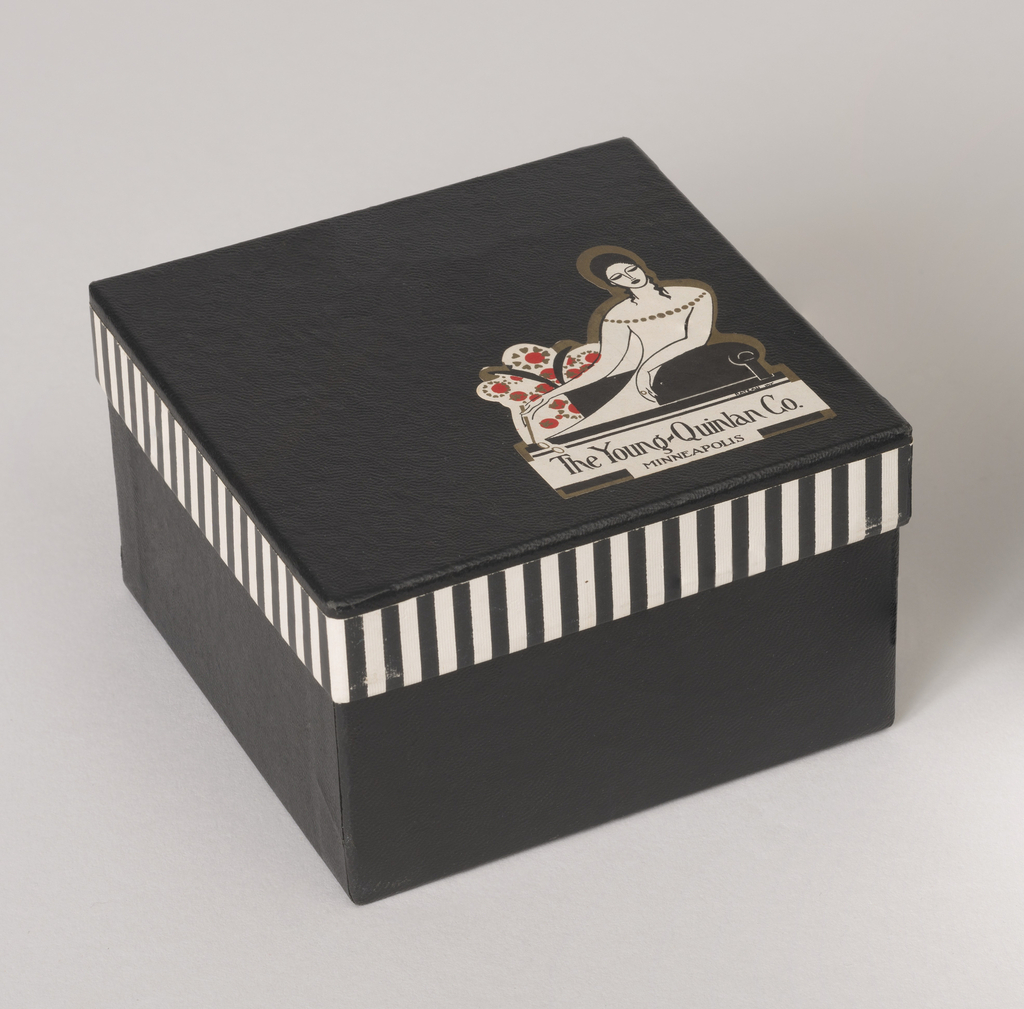Louis Sullivan’s ornament can be appreciated on both a large scale—think Chicago’s Carson Pirie Scott building—and a small one—this cast iron doorplate. Having been removed from its original location during the mid-twentieth century, this doorplate is from Adler & Sullivan’s last commission, the Guaranty Building (now called the Prudential Building). The building became a National...
William De Morgan’s ceramic decoration was often inspired by the medieval world, similar to the practice of his dear friends William Morris and Edward Burne-Jones. De Morgan’s vases and tiles were frequently adorned with fantastical animals, beasts, and grotesques. On this vase, two stylized fish recall the designs found in illuminated manuscripts. Their bodies gently...
Whether you call it a dressing table or a vanity, during the 1930s and 1940s this furniture form expressed the glamour and mystique of femininity. A woman sitting at her vanity—preparing to go out or to entertain in her home—connotes the vanity’s cultural associations with beauty, self-image, and preparation. Designed by Gilbert Rohde for Herman...
Eva Zeisel’s Town and Country line for Minnesota’s Red Wing Potteries, Inc. is an icon of the twentieth-century table. Available in several colors, Town and Country reveals many things—from Zeisel’s unique biomorphic forms, to the emergence of informal dining during the 1940s, to foreshadowing the “atomic” look of tableware in the 1950s. These salt and...
Geometry has always been a friend of the dinner table. During the 18th century both the hexagon and octagon were part of the repertoire of shapes used for plates, teapots, and other dining accoutrements in Europe, as seen in these English Queen Anne style silver salts dating from 1717 and this Chinese export armorial plate...
The luminous iridescent shades of blue in this 8 ¼ inch tall vase are breathtaking. The neck’s chevron pattern resembles the “rippled” and “feathered” glass in Tiffany’s stained glass windows and famed lamps. This shade of blue is similar to the “aurene blue” created by Steuben Glass Works by 1904 and can be seen in a vase , also...
George Nelson and his team at George Nelson Associates were the creative force behind many iconic mid-century furniture designs—such as the “Marshmallow” sofa and various storage systems—but it is in the company’s playful clock designs of the 1950s and 1960s that the whimsy of mid-century modern design excels. The Asterisk wall clock’s simple design relates...
Conjuring up the round abstract shapes and bold colors of Alexander Calder’s hanging mobiles and graphic work, this teapot’s unique shape stands out amongst many of the teapots created by the Hall China Company during the 1930s and 1940s. Making its debut in 1938, the Doughnut teapot was one of several novelty designs created by...
The phantasmal world of Dr. Christopher Dresser’s ornamentation delights both the eye and the imagination. Dating from 1875, this iron hallstand features all the quintessential elements of Dr. Dresser’s highly stylized ornament. The “spikey” floral and figural motifs—also recognizable in this illustration for two grotesque dado rails—and his angular interlaced arabesques are frequently used in...
It is no coincidence that many of Lurelle Van Arsdale Guild’s 1930’s designs for aluminum tableware reflect his honed knowledge of traditional forms and ornament. Before becoming one of America’s top industrial designers of the early to mid-twentieth century, Guild was an antique furniture dealer and throughout his entire life, a collector and connoisseur of...
Designated as the “Royal Porcelain Manufactory” during the mid-eighteenth century under the reign of Louis XV, the Sèvres Porcelain Manufactory needs little introduction as one of Europe’s most innovative and influential porcelain manufacturers during the eighteenth century. Eight years before Sèvres manufactured this cup and saucer in 1780, Louis XVI had become king, and the...
The Model 4083A clock made its debut at the 1933 A Century of Progress Chicago World’s Fair. Designed by Gilbert Rohde and manufactured by the Herman Miller Clock Company, a division of the Herman Miller Furniture Company, this sleek circular clock was one of seven modernist clocks designed by Rohde that were on display in...
Margarete Heymann-Loebenstein-Marks, also known as Grete Marks, was a German ceramicist and painter who studied at the Bauhaus School of Arts in Weimer in 1920–21, alongside Paul Klee and Georg Muche. Prior to this, she had attended the Kunstgewerbeschule in Cologne and studied painting at the Akademie der bildenden Künste in Düsseldorf. Her time at...
The September 1934 issue of The Pottery Gazette and Glass Trade Review features a full-page color advertisement devoted to “Casino” by Royal Doulton. This modern shape debuted a few years earlier and came in three patterns: “Marquis,” “Radiance,” and “Envoy.” Pictured in the advertisement is the earthenware tureen seen here in the museum’s collection. Decorated...
On February 19, 1927, the film “It,” starring Clara Bow, was publicly released in the United States, instantly becoming a box office success and making Clara Bow Hollywood’s first “It girl.” Later that year, Elizabeth C. Quinlan, co-founder of the Young-Quinlan Co., a prestigious Minneapolis department store, visited Paris in search of her own “It...














